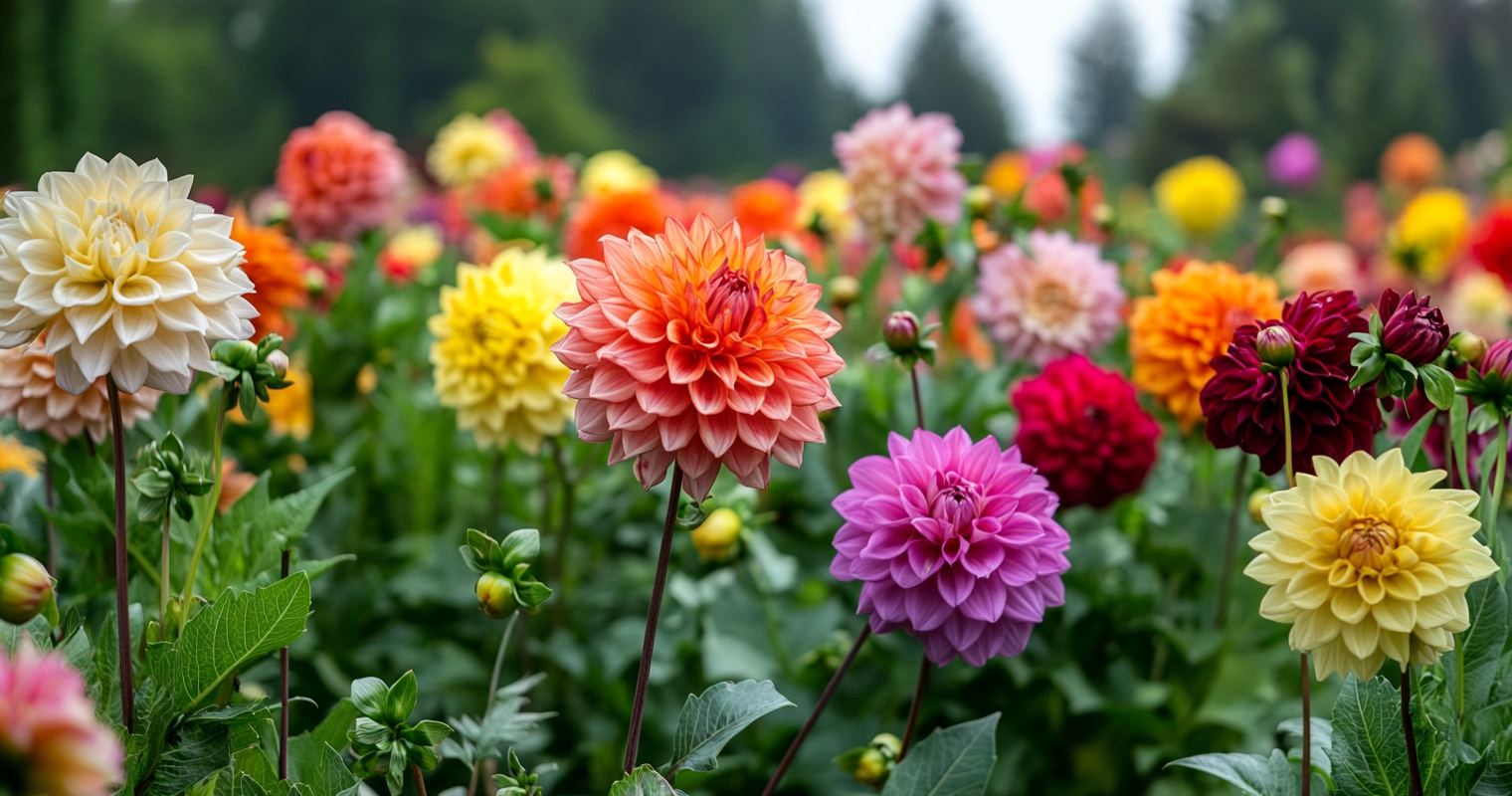Dahlias are a popular choice for gardeners who want to add vibrant color and beauty to their outdoor spaces. Known for their stunning blooms, these flowers come in a variety of shapes, sizes, and colors. Selecting the right dahlias can enhance any garden, creating eye-catching arrangements that turn heads.
Understanding the diverse varieties available can help gardeners make informed choices to achieve the desired aesthetic in their landscapes. With the proper care and planting techniques, dahlias can flourish, bringing joy and splendor for many seasons.
Key Takeaways
- Dahlias offer a stunning range of colors and shapes.
- Choosing the right varieties enhances garden beauty.
- Proper care is essential for thriving dahlia plants.
Reasons to Grow Dahlias in Your Garden
Dahlias are a fantastic choice for any garden, offering vibrant colors and abundant blooms. Once they are established, these flowers can thrive for months, creating a beautiful display. With minimal effort, gardeners can enjoy a continuous array of flowers that brighten up both gardens and homes.
Insider Tips for Cultivating Dahlias
- Select the Right Type: Picking the right dahlia variety is crucial for thriving plants.
- Planting Depth: Ensure tubers are planted about 6 inches deep in the soil.
- Initial Watering: Avoid watering new dahlia tubers immediately after planting to prevent rot.
- Pruning: When reaching about 12 inches in height, pinch the tips to encourage bushier growth.
- Regular Harvesting: Picking blooms frequently will stimulate the plant to produce even more flowers.
These tips, rooted in experience, will help gardeners enjoy the beauty of dahlias while keeping maintenance low.
Favorite Stunning Dahlia Varieties
Here’s a selection of my favorite neutral-colored dahlia types:
- Café Au Lait
- Linda’s Baby
- Crichton Honey
- Peaches N Cream
- Sweet Nathalie
- Platinum Blonde
- Apple Blossom
- Rock Run Ashley
Café Au Lait
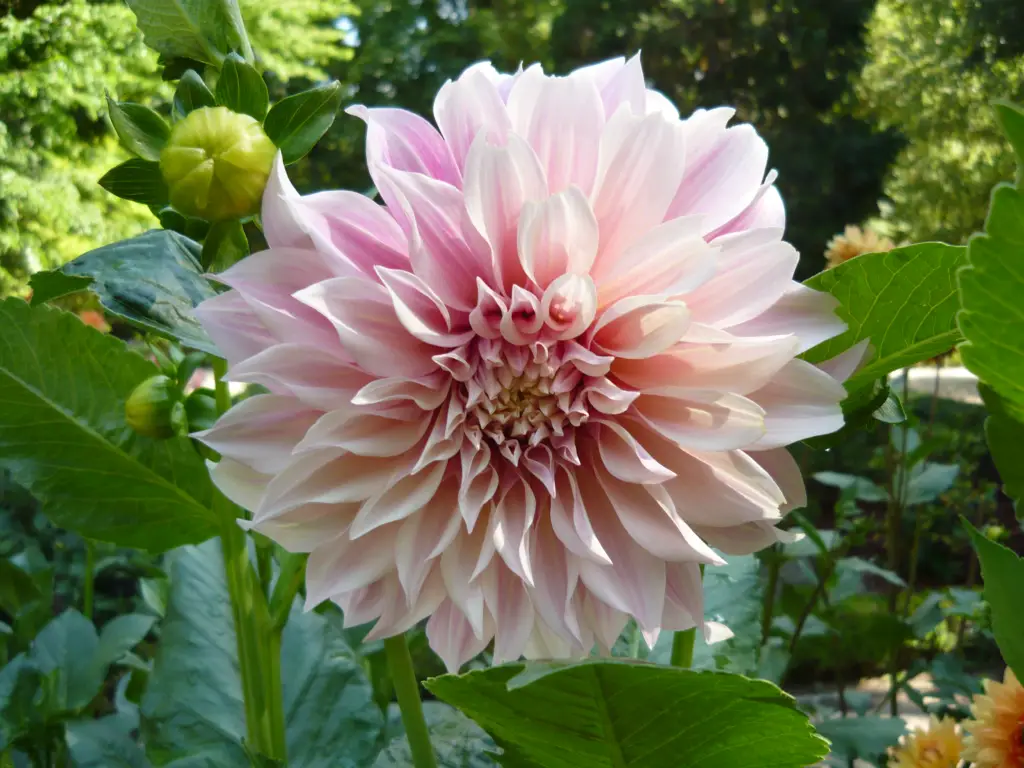
This popular dahlia features large, feathery blossoms that reach up to 9 inches in size. With its delicate milky-pink hue and flat-tipped petals, this flower is often used for wedding arrangements and elegant centerpieces. It definitely stands out in any garden.
- Type: Dinnerplate
- Height: Grows to about 5 feet tall and typically requires staking for support.
- Bloom Size: Approximately 9 inches.
- Days to Maturity: 80-100 days.
- Planting Instructions: Best planted in the spring after the last frost. Dig a hole around 6 inches deep with tuber eyes facing upward. Cover with around 6 inches of compost. Adding worm castings and mycorrhizae can help promote healthy root growth.
- Spacing: Recommended to space at least 18 inches apart.
- Fertilizing: Fertilizer isn’t necessary until sprouts emerge. A balanced fertilizer like 5-10-10 or 10-20-20 can be applied. Alongside, a weekly spray of fish emulsion is beneficial.
Linda’s Baby

This flower presents an antique charm with saturating flamingo pink petals that have hints of pastel yellow at the edges. It’s known for its robust stems and long-lasting blooms, making it a great cut flower.
- Type: Ball
- Height: Reaches about 3.5 feet.
- Bloom Size: Approximately 4.5 inches.
- Days to Maturity: 80-100 days.
- Planting Instructions: Plant in the spring after the frost, digging a 6-inch deep hole with tuber’s eyes facing up. Cover with organics and consider adding growth-promoting substances.
- Spacing: Space plants 12 to 18 inches apart.
- Fertilizing: Similar to others, do not fertilize until sprouts appear. Then, use balanced fertilizers according to package instructions. Including foliar fish emulsion also promotes growth.
Crichton Honey

This shorter type displays a warm mix of apricot and peach shades. It’s an exquisite flower that’s long-lasting and creates gorgeous bouquets.
- Type: Ball
- Height: Grows to around 2-3 feet.
- Bloom Size: About 5 inches.
- Days to Maturity: 80-100 days.
- Spacing: Maintain a distance of 12-18 inches between plants.
- Planting Instructions: As with most dahlias, spring planting is optimal. Dig a 6-inch hole, with tuber eyes positioned correctly, and apply compost.
- Fertilizing: Wait for the first shoots before adding fertilizer, and use recommended doses based on the product chosen.
Peaches N’ Cream
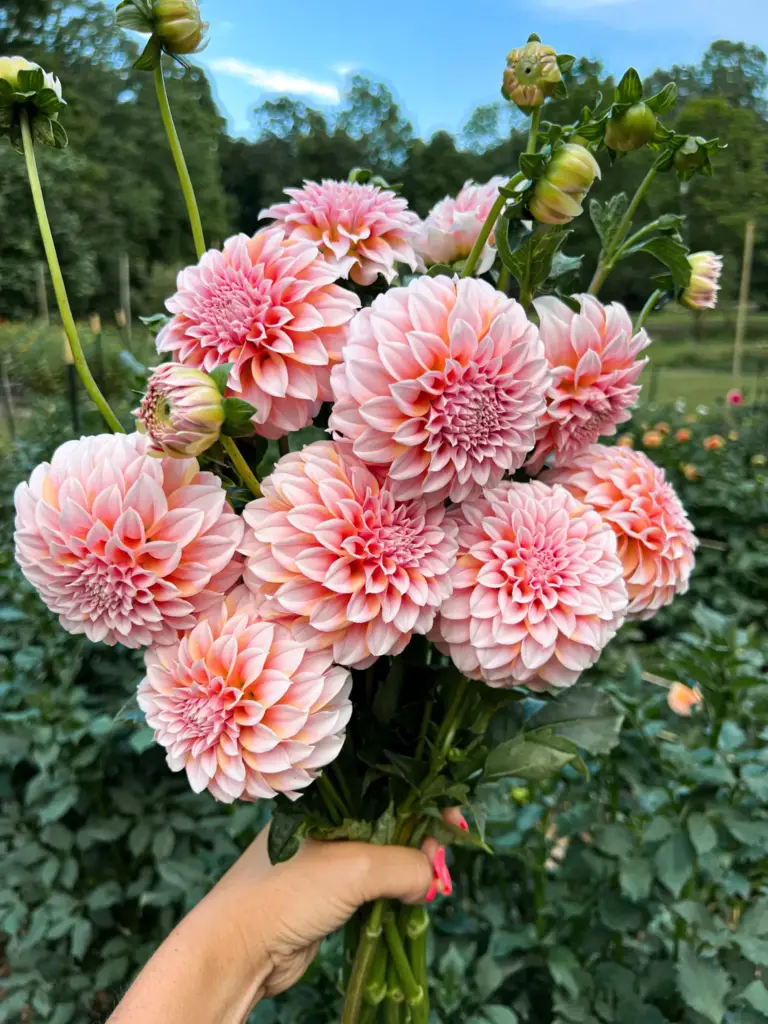
Valued for its unique color variations, this dahlia features shades of cherry blossom intertwined with soft peach hues, making each bloom distinct. It’s a reliable bloomer that is widely sought after as a cut flower.
- Type: Decorative
- Height: About 4.5 to 5 feet tall.
- Bloom Size: Roughly 4 inches across.
- Days to Maturity: 80-100 days.
- Planting Instructions: Similar care is needed; plant in spring in a well-prepared hole, ensuring the tuber’s eyes face up.
- Spacing: Keep around 12-18 inches apart for optimal growth.
- Fertilizing: Again, fertilizing should only commence after shoots are visible.
Sweet Nathalie
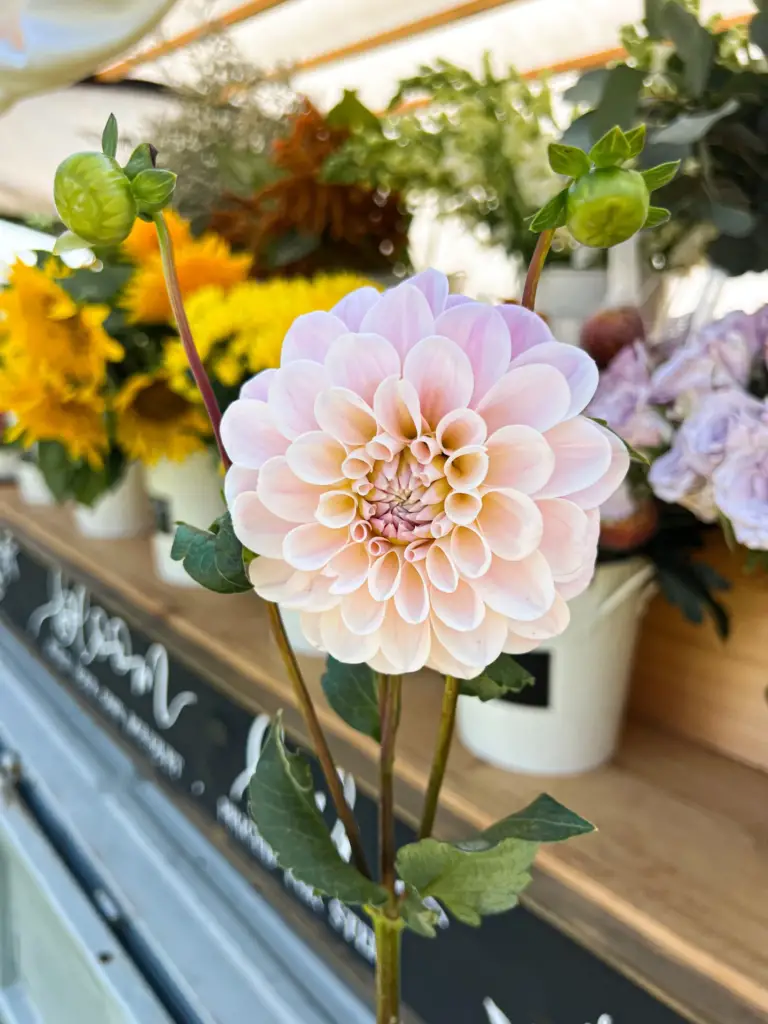
This lovely dahlia boasts creamy pastel pink petals with a buttercream center. It blooms in mid-summer and is particularly attractive when paired with Café Au Lait in floral arrangements.
- Type: Decorative
- Height: Grows to 3.5 feet.
- Bloom Size: About 5 inches.
- Days to Maturity: 80-100 days.
- Planting Instructions: The spring planting routine applies here. Plant the tuber and cover appropriately as discussed.
- Spacing: Allow 12-18 inches between plants.
- Fertilizing: Fertilize only after sprouts appear.
Platinum Blonde
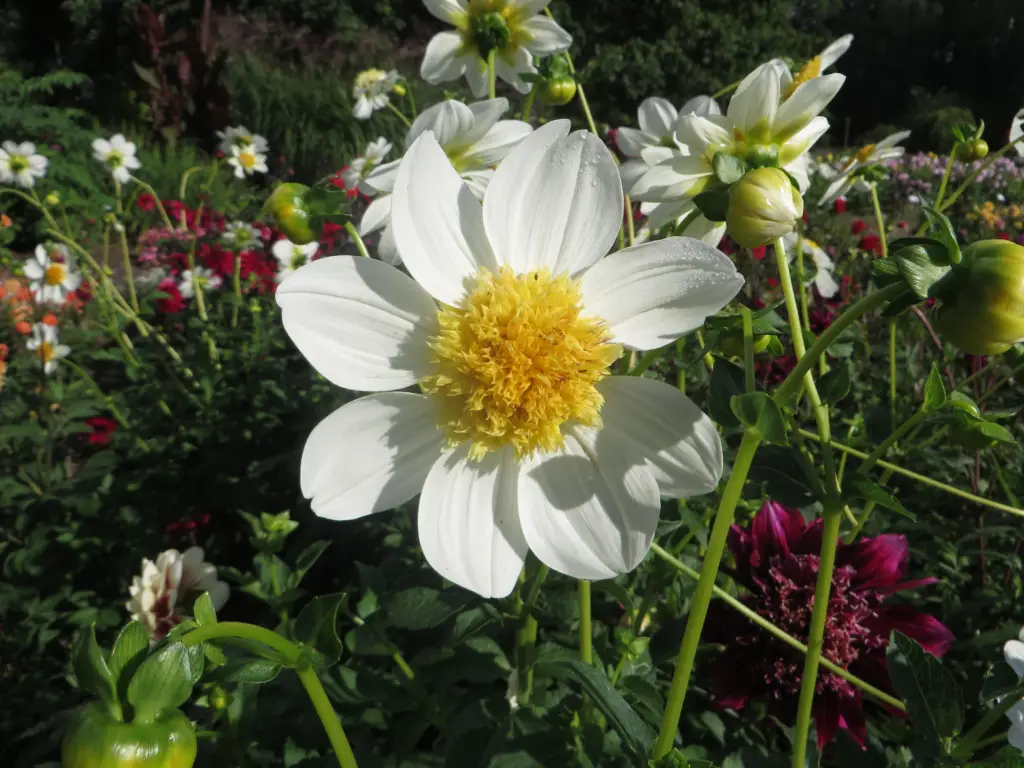
Characterized by its unique white petals that wrap delicate yellow blooms resembling pom-poms, this variety can grow continuously from summer to fall.
- Type: Anemone
- Height: Stands 4-5 feet tall.
- Bloom Size: About 4 inches.
- Days to Maturity: 80-100 days.
- Planting Instructions: Follow the usual spring planting methods to enhance its bloom potential.
- Spacing: Maintain at least 12-18 inches between plants.
- Fertilizing: Start with balanced fertilizers once seen sprouts emerge.
Apple Blossom

This dahlia is known for its light, airy fencing petals that transition from buttercream yellow to pastel pink, featuring a sunflower yellow center. They shine beautifully but are best suited for short-term arrangements due to their limited vase life.
- Type: Anemone
- Height: Reaches 4-5 feet.
- Bloom Size: Approximately 4 inches wide.
- Days to Maturity: 80-100 days.
- Planting Instructions: Like other dahlias, plant in the spring with proper spacing and cover.
- Spacing: Leave at least 12-18 inches between plants.
- Fertilizing: Fertilize after sprouts show.
Rock Run Ashley
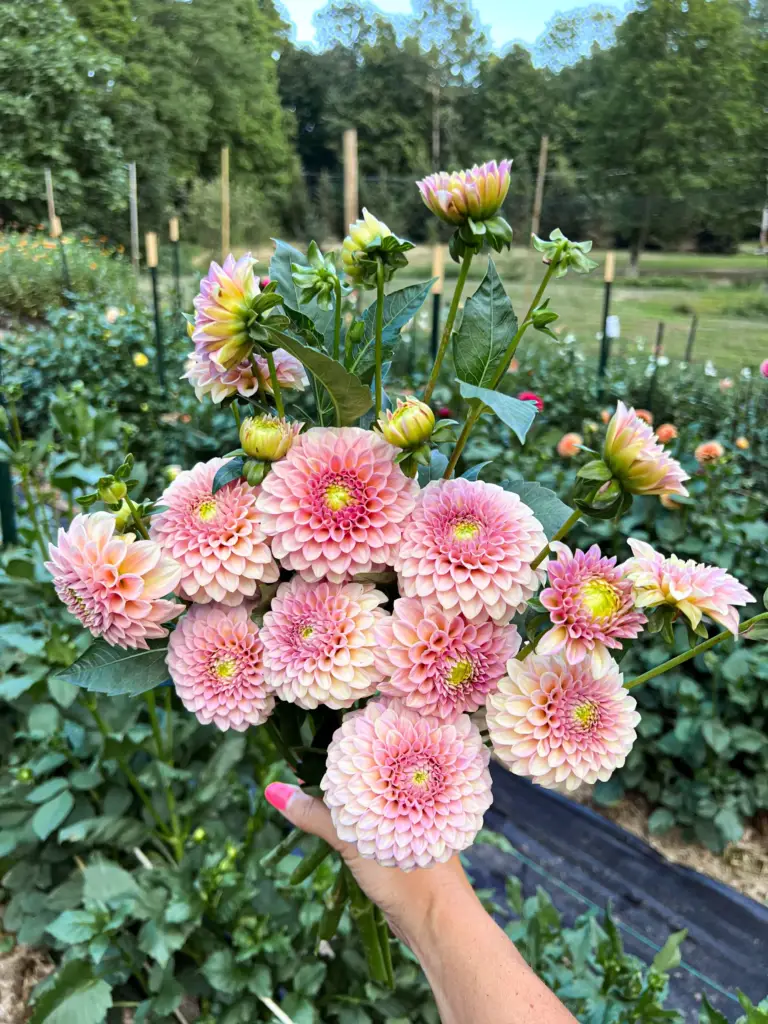
A versatile choice, this flower produces consistent blooms in beautiful buff and blush colors throughout the growing season. Its sturdy stems support its delicate flowers, making it an excellent option for any floral arrangement.
- Type: Formal Decorative
- Height: Grows to about 3 feet.
- Bloom Size: Around 4 inches.
- Days to Maturity: 80-100 days.
- Spacing: Maintain spacing of 12-18 inches.
- Planting Instructions: Plant during spring after frost threats have passed, digging appropriately deep.
- Fertilizing: Fertilization begins after sprouting, using suitable products as needed.
These neutral-colored dahlia varieties add elegance and softness to any garden or bouquet. They thrive with similar care techniques and bring diverse shapes and hues that fit well in various floral designs and landscapes.
More tips to help you grow strong and gorgeous dahlia varieties:
1. Trimming Your Dahlias:
To encourage more blooms, it helps to trim back some of the leaves on the dahlia stalks. When the plants reach a height of 12 to 16 inches and show at least three to four sets of leaves, it’s the right time to prune. The main bud at the top should be pinched or cut just above the next set of leaves. This action stimulates the plant to produce multiple side shoots rather than one central stem, resulting in a greater number of flowers. Additionally, this practice supports the development of sturdier stems.
2. Supporting Your Dahlias:
It is advisable to provide support for dahlias to ensure they grow upright and remain healthy. Ideally, stakes should be placed at the time of planting. Tall wooden stakes can be used to tie individual plants, or gardeners may opt for a method involving t-posts and twine for a more collective support system. This keeps the flowers straight and protects them from falling over, especially when they are loaded with large blooms.
3. Cutting and Maintaining Dahlia Freshness:
For the best results, dahlias should be cut early in the morning when the flowers are half to two-thirds open. The stems should be cut deeply, around 18 inches long, and immediately placed in a plastic bucket with hot water. Using hot water is more effective than cold since it cools down quickly in glass. Adding a flower preservative helps hydrate the blooms. After the water reaches room temperature, the flowers can be arranged in a vase. This method typically provides a vase life of four to seven days, allowing for enjoyment of these lovely, vibrant cut flowers.
Dahlias bring stunning color and beauty to any garden or floral arrangement, making them a wonderful choice for any gardener.
Frequently Asked Questions
What are the best dahlia types for wedding floral designs?
For wedding arrangements, some of the most popular dahlia varieties include Dinnerplate and Peony types. These bloom types are favored for their large, beautiful flowers that add elegance to bouquets and centerpieces. Varieties like ‘Cafe au Lait’ and ‘Fleur’ are especially sought after for their unique colors and stunning appearance.
How can different dahlia types be recognized through images?
To identify various dahlia varieties using photos, one can look for specific characteristics like flower shape, size, and petal arrangement. Many online resources offer visual guides that categorize dahlias into groups based on these traits. Observing details like color intensity and height can also be helpful in distinguishing them.
Which dahlias are ideal for creating eye-catching cut flower arrangements?
Several dahlia varieties stand out for cut flower arrangements. ‘Bishop of Llandaff’ and ‘David Howard’ are known for their striking colors and long stems, making them excellent choices. Additionally, ‘Arabian Night’ offers deep hues, while ‘Chat Noir’ provides a velvety texture that adds interest to bouquets.
Can you provide tall dahlia varieties that work well for garden borders?
For garden borders, tall dahlia varieties like ‘Nuit d’Ete’ and ‘White on Black’ are ideal. They can reach heights of over three feet and create a dramatic display in the garden. ‘Valentine’ is another option, known for its vibrant blooms that stand tall among shorter plants.
What dahlia types are particularly popular with gardeners and florists?
Among gardeners and florists, varieties like ‘Café au Lait’, ‘Peaches n’ Cream’, and ‘Gwenith’ are highly prized. They offer unique colors and sizes that meet the demands of floral arrangements. These dahlias are often requested for their versatility and beauty in both gardens and bouquets.
Are there any plants that should be avoided when planting dahlias together in a garden?
Dahlias should not be planted alongside other tubers like potatoes or plants that attract aphids, such as beans. These companion plants can compete for nutrients or attract pests that harm dahlias. It’s best to choose companion plants that have similar growing conditions and won’t interfere with dahlia growth.

